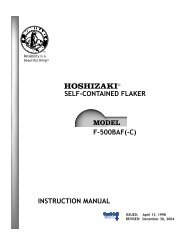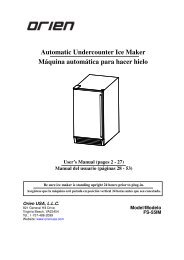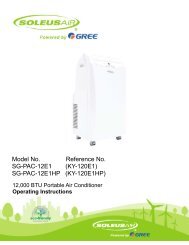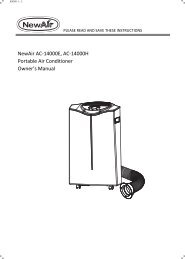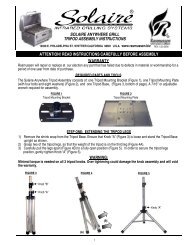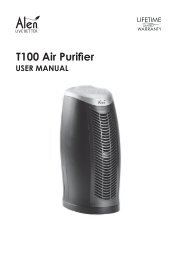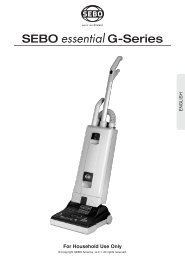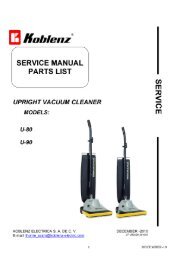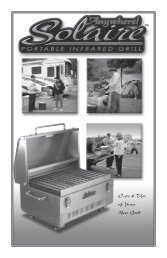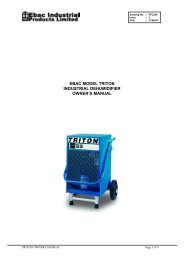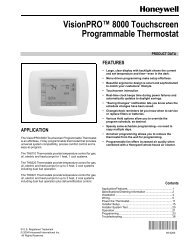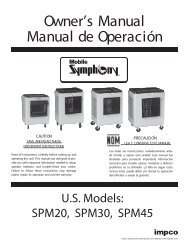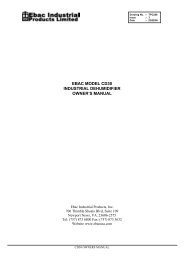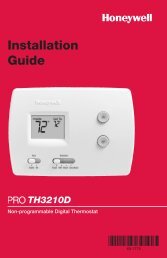68-0133 - Y8610U Intermittent Pilot Retrofit Kit - Air & Water
68-0133 - Y8610U Intermittent Pilot Retrofit Kit - Air & Water
68-0133 - Y8610U Intermittent Pilot Retrofit Kit - Air & Water
You also want an ePaper? Increase the reach of your titles
YUMPU automatically turns print PDFs into web optimized ePapers that Google loves.
ANSI STANDARDS<br />
19<br />
<strong>Y8610U</strong> INTERMITTENT PILOT RETROFIT KIT<br />
Exhibit A<br />
Recommended Procedure for Safety Inspection of an Existing Appliance Installation as a Preliminary Step<br />
to Applying an Automatic <strong>Intermittent</strong> <strong>Pilot</strong> System<br />
The following procedure is intended as a guide to aid in determining that an appliance is properly installed and is in a safe<br />
condition for continuing use.<br />
This procedure is predicated on central furnace and boiler installations equipped with an atmospheric gas burner(s) and not<br />
of the direct vent type. It should be recognized that generalized test procedures cannot anticipate all situations. Accordingly,<br />
in some cases, deviation from this procedure may be necessary to determine safe operation of the equipment.<br />
a. This procedure should be performed prior to any attempt at modification of the appliance or the installation.<br />
b. If it is determined there is a condition which could result in unsafe operation, the appliance should be shut off and the<br />
owner advised of the unsafe condition.<br />
The following steps should be followed in making the safety inspection:<br />
1. Conduct a Gas Leakage Test of the appliance piping and control system downstream of the shut-off valve in the supply<br />
line to the appliance.<br />
2. Visually inspect the venting system for proper size and horizontal pitch and determine there is no blockage or<br />
restrictions, leakage or corrosion or other deficiencies which could cause an unsafe condition.<br />
3. Shut off all gas to the appliance and shut off any other fuel-burning appliance within the same room. Use the shutoff<br />
valve in the supply line to each appliance. If a manual gas valve is not in the gas supply line within 6 feet of the<br />
appliance in an accessible location, one shall be installed.<br />
4. Inspect burners and crossovers for blockage and corrosion.<br />
5. Applicable only to warm air heating appliances. Inspect heat exchangers for cracks, openings or excessive corrosion.<br />
6. Applicable only to boilers. Inspect for evidence of water or combustion product leaks.<br />
7. Insofar as is practical, close all building doors and windows and all doors between the space in which the appliance is<br />
located and other spaces of the building. Turn on clothes dryers. Turn on any exhaust fans, such as range hoods and<br />
bathroom exhausts, so they will operate at maximum speed. Do not operate a summer exhaust fan. Close fireplace<br />
dampers. If, after completing steps 7 through 12, it is believed sufficient combustion air is not available, refer to 1.3.4 of<br />
the National Fuel Gas Code (Z223.1) for guidance.<br />
8. Place in operation the appliance being inspected. Follow the lighting instructions. Adjust thermostat so appliance will<br />
operate continuously.<br />
9. a. Determine that the pilot is burning properly and that main burner ignition is satisfactory by interrupting and reestablishing<br />
the electrical supply to the appliance in any convenient manner.<br />
b. Determine manifold pressure in order to match input after the new control is installed.<br />
10. a. Visually determine that main burner gas is burning properly; i.e., no floating, lifting or flashback. Adjust the<br />
primary air shutter(s) as required.<br />
b. If appliance is equipped with high and low flame control or flame modulation, check for proper main burner operation at<br />
low flame.<br />
11. Test for spillage at the draft hood relief opening after 5 minutes of main burner operation. Use a draft gauge, the flame<br />
of a match or candle, or smoke from a cigarette, cigar or pipe.<br />
12. Return doors, windows, exhaust fans, fireplace dampers and all other fuel-burning appliances to their previous<br />
conditions of use.<br />
13. Applicable only to warm air heating appliances. Check both limit controller and fan controller for proper operation. Limit<br />
controller operation can be checked by temporarily disconnecting the electrical supply to the blower motor and<br />
determining that the limit control acts to shut off the main burner gas.<br />
14. Applicable only to boilers:<br />
a. Determine that the circulating water pumps are in operating condition.<br />
b. Test low water cutoffs, automatic feed controls, pressure and temperature limit controls and relief valves in<br />
accordance with the manufacturer’s recommendations and instructions to determine they are in operating<br />
condition.<br />
Exhibit A of ANSI Standard Z21.71 for Automatic <strong>Intermittent</strong> <strong>Pilot</strong> Ignition Systems for Field Installation.<br />
<strong>68</strong>-<strong>0133</strong>—2



